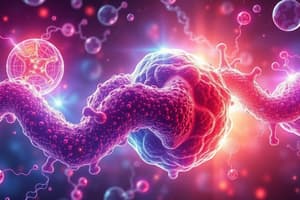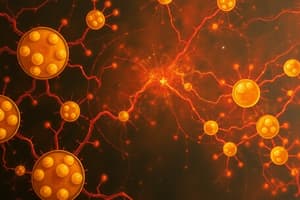Podcast
Questions and Answers
Which enzyme catalyzes the phosphorylation of glucose at the beginning of glycolysis?
Which enzyme catalyzes the phosphorylation of glucose at the beginning of glycolysis?
- Phosphofructokinase
- Hexokinase (correct)
- Pyruvate kinase
- Glycogen synthase
How many molecules of ATP are consumed during the energy-requiring phase of glycolysis?
How many molecules of ATP are consumed during the energy-requiring phase of glycolysis?
- One
- Four
- Three
- Two (correct)
What is the main purpose of the energy-releasing phase of glycolysis?
What is the main purpose of the energy-releasing phase of glycolysis?
- To produce ATP (correct)
- To form acetyl-CoA
- To convert pyruvate to glucose
- To break down fatty acids
Why is the phosphorylation step of glucose considered irreversible in glycolysis?
Why is the phosphorylation step of glucose considered irreversible in glycolysis?
What is the end product of glycolysis that is then further utilized in cellular respiration?
What is the end product of glycolysis that is then further utilized in cellular respiration?
What is the rate-limiting step of glycolysis?
What is the rate-limiting step of glycolysis?
Which enzyme catalyzes the conversion of dihydroxyacetone phosphate to glyceraldehyde-3-phosphate in glycolysis?
Which enzyme catalyzes the conversion of dihydroxyacetone phosphate to glyceraldehyde-3-phosphate in glycolysis?
How many net ATP molecules are produced in glycolysis?
How many net ATP molecules are produced in glycolysis?
What is the fate of pyruvate in anaerobic conditions?
What is the fate of pyruvate in anaerobic conditions?
Which enzyme regulates the rate of glycolysis by catalyzing the phosphorylation of glucose?
Which enzyme regulates the rate of glycolysis by catalyzing the phosphorylation of glucose?
Study Notes
Glycolysis: The Central Pathway of Cellular Metabolism
Glycolysis is a fundamental metabolic pathway that plays a crucial role in cellular energy production. It is a series of chemical reactions that occur in the cytoplasm of cells, converting a single molecule of glucose into two molecules of pyruvate. Glycolysis is the first step in cellular respiration and is an essential process for generating ATP, the primary energy source for cells. The process is shared by all living organisms, from bacteria to humans, and is a testament to its importance in maintaining life.
Glycolysis: A Two-Phase Process
Glycolysis can be divided into two main phases: the energy-requiring phase and the energy-releasing phase. The energy-requiring phase, also known as the investment phase, involves the initial steps of glucose phosphorylation, which consume two molecules of ATP. The energy-releasing phase, also known as the payoff phase, consists of the latter steps, where ATP is generated from the products of the energy-requiring phase.
Energy-Requiring Phase
The energy-requiring phase begins with the phosphorylation of glucose by the enzyme hexokinase or glucokinase, which is the first intracellular reaction of glycolysis. This reaction traps glucose inside the cell and is considered irreversible. The phosphorylation step consumes one molecule of ATP, making it an investment reaction. The phosphorylated glucose molecule is then isomerized by phosphoglucose isomerase, which is a readily reversible reaction and serves in both glycolysis and gluconeogenesis.
Energy-Releasing Phase
The energy-releasing phase starts with the reaction catalyzed by 6-phosphofructose-1-kinase (PFK-1), which is the rate-limiting step of glycolysis and the committed step of the pathway. This reaction phosphorylates fructose-6-phosphate to form fructose-1,6-bisphosphate, which is then split into dihydroxyacetone phosphate and glyceraldehyde-3-phosphate by the enzyme aldolase. The molecule of dihydroxyacetone phosphate is isomerized to glyceraldehyde-3-phosphate by triose phosphate isomerase, forming two glyceraldehyde-3-phosphate molecules.
Glycolysis and ATP Production
Glycolysis generates a net production of two ATP molecules. The first ATP is produced during the phosphorylation of glucose by hexokinase, and the second ATP is produced during the conversion of 1,3-bisphosphoglycerate to 3-phosphoglycerate by phosphoglycerate kinase. In addition, glycolysis generates two NADH molecules, which are crucial for the subsequent electron transport chain.
Pyruvate: The End of Glycolysis
The final product of glycolysis is pyruvate, which can be further metabolized in the presence of oxygen. In aerobic conditions, pyruvate enters the citric acid cycle, where it undergoes oxidative phosphorylation, producing a net of 32 ATP molecules. In anaerobic conditions, pyruvate is converted to lactate, which serves as a precursor for other reactions.
Regulation of Glycolysis
Glycolysis is a tightly regulated pathway that can be controlled by various factors, including the availability of glucose and the presence of oxygen. Enzymes such as hexokinase, phosphofructokinase, glyceraldehyde-3-phosphate dehydrogenase, and pyruvate kinase regulate the rate of glycolysis. The availability of oxygen can also impact the process, with the "Pasteur effect" describing how the availability of oxygen diminishes the effect of glycolysis, and decreased availability leads to an acceleration of glycolysis.
Conclusion
Glycolysis is a fundamental metabolic pathway that plays a central role in cellular energy production. It is a highly regulated process that provides cells with the energy needed to maintain life and carry out essential functions. The process is shared by all living organisms and is a testament to its importance in maintaining life.
Studying That Suits You
Use AI to generate personalized quizzes and flashcards to suit your learning preferences.
Description
Test your knowledge on glycolysis, the fundamental metabolic pathway that converts glucose into pyruvate, providing cells with energy in the form of ATP. Explore the energy-requiring and energy-releasing phases, as well as the regulations and end products of glycolysis.




